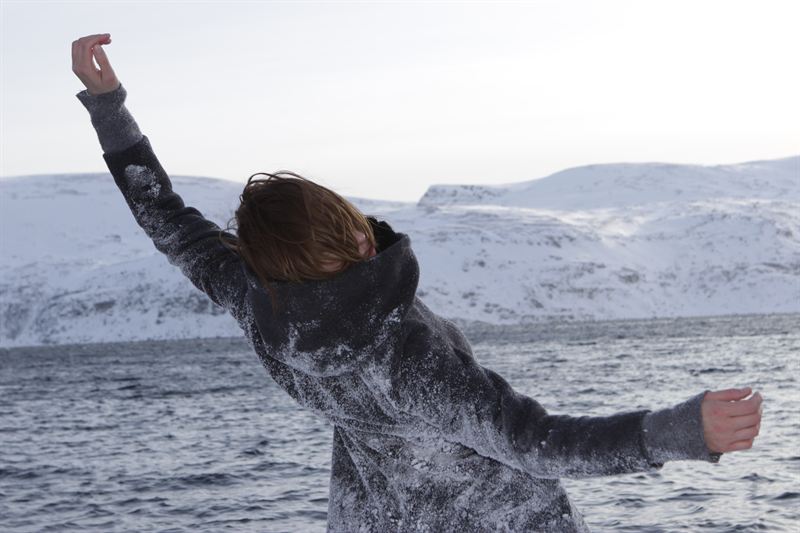Dance - a Catalyst for Cultural Growth in Rural Areas

Press images available
Wilderness Dance sends 10 Nordic-Baltic dance companies on residency stays in communities on the edge of the Nordic-Baltic region. Both the local communities as well as the artists benefit from it.
Wilderness Dance is the title of a one-of-a-kind project that provides opportunity for 10 contemporary dance companies to reside and work in 2 smaller communities in the Nordic-Baltic region. Here the altogether 55 individuals conduct innovative artistic research, engaging the local population. A high level of involvement is prioritized, meaning that hundreds of local inhabitants are expected to be directly or indirectly involved in the activities. So far, artists have visited two places in Iceland, Hammerfest in Nothern Norway and a group just arrived in Hailuoto Island, in Northern Finland. Wilderness dance is the largest most extensive residency programme for dance in the region. Cultural houses as well as schools are arenas for the groups to work, inspirered by the specific geography, culture, and milieu of the locations.
Building relationships in minus 10 degrees
Currently the Icelandic choreographer and dancer Margrét Sara Guðjónsdóttir together with fellow artists Laura Siegmund, Angela Schubot, and Suet-Wan Tsang is visiting Hailuoto Island 50 km from Oulu in Northern Finland. Their work in the community will center around the relationship between performers and audience.
More about Margret Sara Guðjónsdóttir: www.panicproductions.is/about/default.aspx
The Helsinki based danceproduction company MAD is the organizing partner collaborating with the local Finnish host JoJo – Oulu Dance Center.
Nature as inspiration
The idea behind the initative is that dance should not be a secluded artform, presented mainly in bigger cities, but should be accessible for more people and, by way of its inherent qualities, can be a tool for cultural development in smaller communities. Moreover, the proximity of nature in the involved communities is for the city-based dancers and choregraphers a source of inspiration, forcing them to review their own city-behaviour and adjust to forces out of their immediate control. Nature represents at the same time the given conditions for all life, yet is also highly unstable, -most notably via the climate of the Nordic-Baltic region which changes a lot and has for the artists proved to be a welcomed challenge.
Dance companies from 7 countries
The involved artists are established dancecompanies with dancers all from the same country or people who have decided to work together in interesting cross-border combinations. In their first residency period the artists will typically work in a more explorative way. In their second period they are asked to work towards producing a performance/art work to present at the residency location. Furthermore a number of these works will be chosen for further presentation in the Nordic-Baltic area and possibly in other European countries.
Ten Nordic and Baltic locations
The Wilderness residencies will be held in Tønder and Ringkøbing, Denmark; Dviete and Ainazi, Latvia; Hailuoto and Kangasniemi, Finland; Fljótsdalshérað and Hornafjörður, Iceland and Stamsund and Hammerfest in Norway, North of the Arctic Circle. Each dance company spends three weeks in two of these communities.
Blog from the field
The involved artists have blogged about their experiences which among other things have involved strenuous travelling, trips in rough nature, conducting workshops for children, visiting private homes and showing their artistic work to local audiences.
EU Culture Programme funded project keðja, behind Wilderness Dance
SL Independent Theatres and Performing Arts Iceland and 4 other partners, organize Wilderness Dance which is part of the 3-year project keðja 2012-2015, headed by Dansehallerne in Copenhagen.
keðjas activities which also consists of Think Tanks, Seminars, Writing Labs and a Mentoring Scheme, are funded among others by the European Union’s cultural programme as well as the Nordic Mobility- and Art & Culture Programmes and Nordic Culture Fund. The activities are a continuation of keðja’s first Nordic-Baltic activities which took place 2008-2011.
About keðja 2012-2015:
- keðja means chain in Icelandic.
- keðja has until now involved 1300 dance professionals from the Nordic and Baltic countries.
- keðja has implemented activities in 8 Nordic and Baltic countries. In the next 2 years, this will be expanded to 9 countries/autonomous areas in all.
- Dansehallerne in Copenhagen has been head of keðja since 2007.
The Wilderness partners are: Independent Theatres Association (main Wilderness organizer in collaboration with Performing Arts Iceland), Reykjavik; Bora Bora, Aarhus; Danseareana nord, Hammerfest; MAD Production, Helsinki; New Theatre Institute of Latvia, Riga.
Other keðja partners are: Dance Info Finland, Helsinki; Dance Information Norway, Oslo; Union of Estonian Dance Artists, Estonia; Fish Eye, Klaipeda; SITE, Stockholm as well as associated partner Kultur i Väst, Göteborg.
Please visit:
http://kedjawilderness.tumblr.com/
www.kedja.net
www.facebook.com/Kedja2012
Contacts
For information about Wilderness Dance and other keðja activities, please contact:
Kamma Siegumfeldt, project manager keðja, phone: +45 21 49 04 11
For information about Wilderness Dance contact:
Ása Richardsdottir, asa@stage.is , phone: +354 664 0404
For information /contact to artist Margrét Sara Guðjónsdóttir and the Finnish organizers, contact:
Outi Järvinen, outi@artsmanagement.fi , phone: +358 41 545 6255 or
Sari Palmgren, sari@loikka.fi , phone: +358 50541010
Tags:


